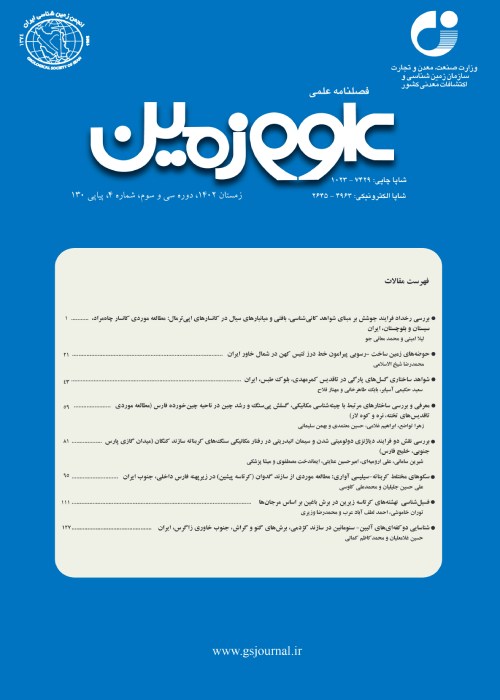Ore mineralization and fluid inclusion and sulfur isotope studies on the Shekarbeig deposit, southwest Mahabad, Sanandaj- Sirjan Zone
Author(s):
Abstract:
Shekarbeig barite deposit is located 46 km southwest of Mahabad in northwestern part of the Sanandaj-Sirjan zone. The outcropped rock units in the area are Late Protrozoic metamorphosed volcano-sedimentary rocks, equivalent to Kahar Formation. The main ore mineral occurs as stratiform barite lenses in three horizons accompanied by sulfide minerals as massive and/or parallel bands within metamorphosed rhyolitic tuffs (metatuff). The deposit footwall is composed of phyllite and slate crosscut by silicic and sulfide-bearing barite veins and veinlets (stringer zone). Primary minerals in the ore are mainly barite, pyrite, marcasite, chalcopyrite and bornite and secondary minerals are chalcocite, covellite, malachite, siderite, goethite, hematite and other iron hydroxides. Gangue minerals include quartz, sericite, calcite, dolomite, feldspar and chlorite. In terms of metallic ores, the Shekarbeig deposit does not vary much having only pyrite and chalcopyrite. Types of fluid inclusions in the Shekarbeig deposit are two-phase liquid-vapour (LV), mono-phase vapour and mono-phase liquid; two-phase liquid-vapour being the dominant type in both stringer and stratiform parts. Sulfur isotope data indicate that seawater was the main mineralizing fluid for Shekarbeig mineralization. These data suggest that complete reduction of recent seawater sulfate and the rate of mixing of hydrothermal solution with cold waters in deep parts of the basin may result in precipitation of large amount of sulfides in the stringer and stratifrom zones. On the other hand, partial reduction of recent seawater sulfates provided required sulfur for the deposition of barite. Geological evidence, evaluation, lithostratigraphy, mineralization geometry and the results of fluid inclusion and sulfur isotope studies for samples from the Shekarbeig deposit indicate derivation of the hydrothermal fluids of low salinity and moderate temperature from seawater and circulation and upward movement by a heating source (probably subvolcanic intrusions) and finally cooling and deposition of the fluids as sulfate and sulfide on the sea floor due to mixing with seawater, similar to massive sulfide Kuroko-type deposits.
Keywords:
Language:
Persian
Published:
Geosciences Scientific Quarterly Journal, Volume:26 Issue: 103, 2017
Pages:
201 to 218
magiran.com/p1700150
دانلود و مطالعه متن این مقاله با یکی از روشهای زیر امکان پذیر است:
اشتراک شخصی
با عضویت و پرداخت آنلاین حق اشتراک یکساله به مبلغ 1,390,000ريال میتوانید 70 عنوان مطلب دانلود کنید!
اشتراک سازمانی
به کتابخانه دانشگاه یا محل کار خود پیشنهاد کنید تا اشتراک سازمانی این پایگاه را برای دسترسی نامحدود همه کاربران به متن مطالب تهیه نمایند!
توجه!
- حق عضویت دریافتی صرف حمایت از نشریات عضو و نگهداری، تکمیل و توسعه مگیران میشود.
- پرداخت حق اشتراک و دانلود مقالات اجازه بازنشر آن در سایر رسانههای چاپی و دیجیتال را به کاربر نمیدهد.
In order to view content subscription is required
Personal subscription
Subscribe magiran.com for 70 € euros via PayPal and download 70 articles during a year.
Organization subscription
Please contact us to subscribe your university or library for unlimited access!



